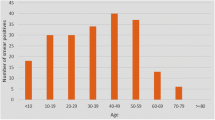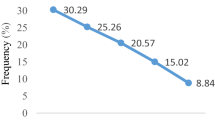Abstract
Cutaneous leishmaniasis (CL) is the first and most important vector-borne zoonotic disease transmitted by sand flies in Iran. As a parasitic disease in the Old World, it is a complex zoonosis with multiple vertebrate hosts and arthropod vectors of pathogenic flagellate protozoan in the genus of Leishmania in different parts of its range. Phlebotomine sand flies are proven as vectors of this parasite which can be transmitted through the bite of an infected female sand fly distributed in almost all parts of Iran. This research performed on all CL patients as that were registered into special forms by physicians and experts during the study period 2006–2013 in the county town of Fasa, Iran. Data were analyzed by Chi square test using SPSS 17 statistics software. Overall, 1,908 patients (59.18 %) lived in rural and 1,316 (40.82 %) lived in urban areas. All ages were between 1 and ≥30 year. The most frequent age group was ≥20 years (54.6 %). Sex ratio of patients was almost 1:1 (1,561; 48.42 % male vs. 1,663; 51.58 % female). Most of them (66.84 %) had wet lesions and those with dry lesions were less frequent (33.16 %). There was a significant difference between the frequencies of these two groups (P < 0.05). Hand ulcers were the most prevalent part of body (43.24 %). The highest prevalence rate (35.14 %) of lesions occurred in autumn. The unstable trend of this disease in different years and its relatively high disease burden affecting all age groups in Fasa with respect to other counties in Iran showed that it was most likely an endemic disease in this region.


Similar content being viewed by others
References
Ashford RW (1999) Cutaneous leishmaniasis: strategies for prevention. Clin Dermatol 17:327–332
Ashford RW, Desjeux P, de Raadt P (1992) Estimation of population at risk of infection and numbers of cases of leishmaniasis. Parasitol Today 8:104–105
Azizi K, Abedi F, Moemenbellah-Fard MD (2012a) Identification and frequency distribution of Leishmania (L.) major infections in sand flies from a new endemic ZCL focus in southeast Iran. Parasitol Res 111:1821–1826
Azizi K, Moemenbellah-Fard MD, Kalantari M, Fakoorziba MR (2012b) Molecular detection of Leishmania major kDNA from wild rodents in a new focus of zoonotic cutaneous leishmaniasis in an oriental region of Iran. Vector-Borne Zoonotic Dis 12(10):844–850
Azizi K, Fakoorziba MR, Jalali M, Moemenbellah-Fard MD (2012c) First molecular detection of Leishmania major within naturally infected Phlebotomus salehi from a zoonotic cutaneous leishmaniasis focus in southern Iran. Trop Biomed 29:1–8
Davami MH, Motazedian MH, Sarkari B (2010) The changing profile of cutaneous leishmaniasis in a focus of the disease in Jahrom district, southern Iran. Ann Trop Med Parasitol 104:377–382
Desjeux P (1996) Leishmaniasis: public health aspects and control. Clin Dermatol 14:417–423
Desjeux P (2001) The increase in risk factors for leishmaniasis worldwide. Trans R Soc Trop Med Hyg 95:239–243
Desjeux P (2004) Leishmaniasis: current situation and new perspectives. Comp Immunol Microbiol Infect Dis 27:305–318
Karimi A, Hanafi-Bojd AA, Yaghoobi-Ershadi MR, Akhavan AA, Ghezelbash Z (2014) Spatial and temporal distributions of phlebotomine sand flies (Diptera: Psychodidae), vectors of leishmaniasis, in Iran. Acta Trop 132:131–139
Kassiri H, Sharifinia N, Jalilian M, Shemshad K (2012) Epidemiological aspects of cutaneous leishmaniasis in Ilam province, west of Iran. Asian Pac J Trop Dis 2(S1):S382–S386
Magill AJ (2005) Cutaneous leishmaniasis in the returning traveler. Infect Dis Clin North Am 19(1):241–266
Maroli M, Feliciangeli MD, Bichaud L, Charrel RN, Gradoni L (2013) Phlebotomine sand flies and the spreading of leishmaniases and other diseases of public health concern. Med Vet Entomol 27:123–147
Mehrabani D, Motazedian MH, Hatam GR, Asgari Q, Owji SM, Oryan A (2011) Leishmania major in Tatera indica in Fasa, southern Iran: microscopy, culture, isoenzyme, PCR and morphologic study. Asian J Anim Vet Adv 6(3):255–264
Moemenbellah-Fard MD, Saleh V, Banafshi O, Dabaghmanesh T (2012) Malaria elimination trend from a hypo-endemic unstable active focus in southern Iran: predisposing climatic factors. Pathog Glob Health 106:358–365
Moemenbellah-Fard MD, Shahriari B, Azizi K, Fakoorziba MR, Mohammadi J, Amin M (2014) Faunal distribution of fleas and their blood-feeding preferences using enzyme-linked immunosorbent assays from farm animals and human shelters in a new rural region of southern Iran. J Parasit Dis. doi:10.1007/s12639-014-0471-1
Molyneux DH (2004) “Neglected” diseases but unrecognized successes—challenges and opportunities for infectious disease control. Lancet 364:380–383
Motazedian MH, Noamanpoor B, Ardehali S (2002) Characterization of Leishmania parasites isolated from provinces of the Islamic Republic of Iran. East Mediterr Health J 8:338–344
Nateghi Rostami M, Saghafipour A, Vesali E (2013) A newly emerged cutaneous leishmaniasis focus in central Iran. Int J Infect Dis 17:e1198–e1206
Nazari N, Faraji R, Vejdani M, Mekaeili A, Hamzavi Y (2012) The prevalence of cutaneous leishmaniases in patients referred to Kermanshah hygienic centers. Zahedan J Res Med Sci 14(8):77–79
Parvin-Jahromi H (2012) The faunestic study of sand flies (Diptera: Psychodidae) and detection of vectors of cutaneous leishmaniasis using PCR in Fasa county, Fars province. M.Sc. thesis in medical entomology, School of Health, SUMS, Shiraz, Iran, 190 pp
Parvizi P, Alaeenovin E, Kazerooni PA, Ready PD (2013) Low diversity of Leishmania parasites in sand flies and the absence of the great gerbil in foci of zoonotic cutaneous leishmaniasis in Fars province, southern Iran. Trans R Soc Trop Med Hyg 107:356–362
Razmjou S, Hejazi H, Motazedian MH, Baghaei M, Emamy M, Kalantary M (2009) A new focus of zoonotic cutaneous leishmaniasis in Shiraz, Iran. Trans R Soc Trop Med Hyg 103:727–730
Reithinger R, Mohsen M, Leslie T (2010) Risk factors for anthroponotic cutaneous leishmaniasis at the household level in Kabul, Afghanistan. PLoS Negl Trop Dis 4(3):e0000639
Sacks DL (2001) Leishmania-sand fly interactions controlling species-specific vector competence. Cell Microbiol 3(4):189–196
Sarkari B, Asgari Q, Shafaf MR (2014) Knowledge, attitude, and practices related to cutaneous leishmaniasis in an endemic focus of cutaneous leishmaniasis, southern Iran. Asian Pac J Trop Biomed 4(7):566–569
Sharafi M, Pezeshki B, Reisi A, Kalantari M, Naghizadeh MM, Dast-Manesh S (2013) Detection of cutaneous leishmaniasis by PCR in Fasa district in 2012. J Fasa Univ Med Sci 3(3):266–270
Tashakori M, Al-Jawabreh A, Kuhls K, Schönian G (2011) Multilocus microsatellite typing shows three different genetic clusters of Leishmania major in Iran. Microbes Infect 13(11):937–942
World Health Organization (2010) Report of a meeting of the WHO expert committee on the control of leishmaniases, Geneva. Tech Rep Ser 949:22–26
Yaghoobi-Ershadi MR et al (2001) Epidemiological study in a new focus of cutaneous leishmaniasis due to Leishmania major in Ardestan town, central Iran. Acta Trop 79:115–121
Acknowledgments
The present paper was extracted from the results of an approved M.Sc. student project (No: 90-3318 dated 12 July 2012) conducted by the first author, Mr. M. Khosravani. Thanks are due to the Vice-Chancellor for Research and Technology at SUMS, for permitting the use of facilities and financial support of this project at the university.
Author information
Authors and Affiliations
Corresponding author
Rights and permissions
About this article
Cite this article
Khosravani, M., Moemenbellah-Fard, M.D., Sharafi, M. et al. Epidemiologic profile of oriental sore caused by Leishmania parasites in a new endemic focus of cutaneous leishmaniasis, southern Iran. J Parasit Dis 40, 1077–1081 (2016). https://doi.org/10.1007/s12639-014-0637-x
Received:
Accepted:
Published:
Issue Date:
DOI: https://doi.org/10.1007/s12639-014-0637-x




